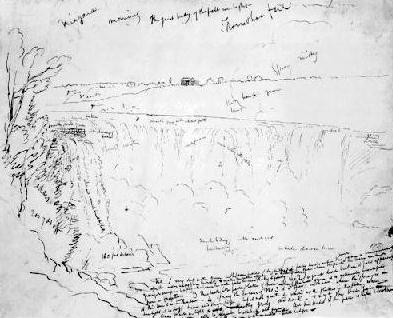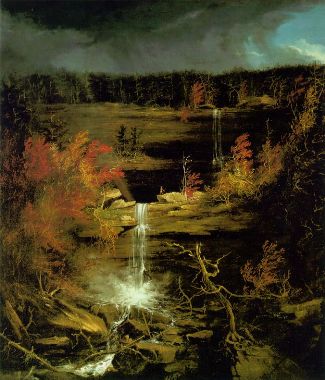Examples 7-12
Example 7
Student Citation: According to art historian Barbara Novak, nineteenth-century painters were "priests of the natural church," destined to communicate the divine nature of the American landscape through visual representation (9).1
Student Footnote: 1. In 1980’s Nature and Culture: American Landscape and Painting 1825-1875, Novak argues that the connections contemporary society made between the divine and the natural world resulted in a values-based constraint upon landscape artists, who had to be concerned with their "moral duties" as well as their aesthetic ones (9).
Is this an example of a useful, properly-formatted citation and footnote?
Yes. The citation is properly documented, with the name of the author and the page number. The footnote not only provides further documentation of the source, it expands upon Novak's argument. If the footnote simply further documented the source of the information presented in the body of the paper, then its usefulness would be questionable.
Example 8

Cole, Thomas. Niagara Falls, 1829.
Original Text: "The nineteenth century rings with exhortations to the artist on the high moral duties of his exceptional calling—entirely proper for landscape painters, those priests of the natural church. There is no question, in early-nineteenth-century America, of the intimate relation between art and society, a fact that has to be emphasized after a century of modernism" (Novak 9).
Student Paraphrase: The nineteenth-century was a period in which society had a close relationship with art, and all artists were advised of their roles as both aesthetic creators and as individuals with the duty of favorably representing the morals of contemporary society. This was particularly important, if often problematic, for landscape painters, who created visual depictions of things the society of the time found divine in nature (Novak 9).
Is this an adequate paraphrase?
No. It interprets and expands upon the meaning of the original. The highlighted portions of the paraphrase, below, are the interpretation of the reader. While they may well be ideas present in Novak’s text as a whole, they are not present in the paraphrased passage:
The nineteenth-century was a period in which society had a close relationship with art, and all artists were advised of their roles as both aesthetic creators and as individuals with the duty of favorably representing the morals of contemporary society. This was particularly important, if often problematic, for landscape painters, who created visual depictions of things the society of the time found divine in nature (Novak 9).
Example 9
Original Text: "God in or revealed through nature is accessible to every man, and every man can thus 'commune' (as the word was) with nature and partake in the divine. God in nature speaks to God in man. (This can be seen as a way of moving man back to the center of the universe, using as passport a discreet humility, which is confident, however, of its ultimate virtue and godliness.)" (Novak 15).
Student Summary: Novak claims that the connection made in nineteenth-century society between God and nature allowed the people of the era to make man the center of the natural and spiritual universe (Nature and Culture 15).
Is this an accurate summary?
No, it misses the primary point. The primary focus of this passage is not in the parenthetical interjection, but in the lines that precede it. The summary fails to represent the relationships between the ideas as presented in the source material.
Example 10

Cole, Thomas. Sketch for Niagara Falls, ca. 1829.
Original Text: "…man can also commune with man through nature—a communing which requires for its representation not the solitary figure, but two figures in a landscape" (Novak 15).
Student Text: The visual representation of two figures in a landscape, rather than a solitary figure, is a depiction of the idea that human beings can commune with each other through nature.
Is this an act of plagiarism?
Yes, but it could be rectified through the use of parenthetical citation. If in-text citation information was presented at the end of the sentence, the language and ideas presented by the student are different enough from the original that this could be considered an adequate paraphrase.
Example 11
Student Citation: A prominent art historian claims that in the 1800s "a range of religious, moral, philosophic, and social ideas" were "projected onto the American landscape."
No footnote, no Works Cited page.
Is this an accurate citation?
No. Neither the name of the author or the title of the source text are mentioned. While it is permissible to refer to the author of an external source in this fashion, doing so at the expense of providing the author's proper name, or the text in which the quotation is located, confuses the reader and substantially weakens the paper.
Example 12

Cole, Thomas. Falls of Kaaterskill, 1826.
Student Citation: A prominent art historian claims that in the 1800s "a range of religious, moral, philosophic, and social ideas" were "projected onto the American landscape" (Novak, Nature and Culture, 1980, 15).
From the student's Works Cited page:
Novak, Barbara. Nature and Culture: American Landscape and Painting 1825-1875. New York: Oxford University Press, 1980.
Is this an adequate citation?
No, because the date of publication is not necessary in an in-text citation in MLA format. If a complete reference is included on a student's Works Cited page, then the date of publication, unless it is relevant to the paper, may be omitted from an in-text citation. While this particular citation may seem repetitive, if a paper incorporates multiple works by one author it is helpful to differentiate by title inside parenthetical citations where the specific source text may be in doubt. The location of citation information is up to the individual writer.